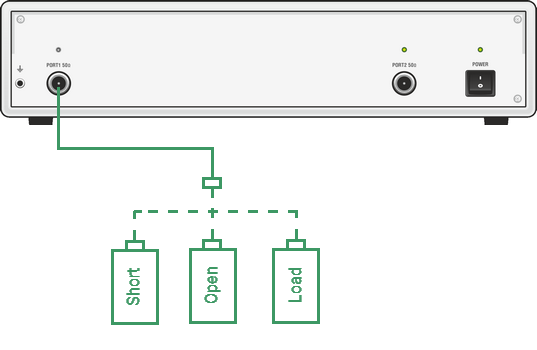|
Analyzer Calibration for Reflection Coefficient Measurement |
Scroll Contact Us Home Prev Top Next More |
Calibration of the entire measurement setup — which includes the Analyzer, cables and adapters involved for the DUT connection — greatly enhances the accuracy of the measurement.
To perform full one-port calibration, prepare the kit of calibration standards: OPEN, SHORT and LOAD. To perform proper calibration, select the correct kit type in the program. This kit contains a description and specifications of the standards
To perform full one-port calibration, connect calibration standards to the test port one after another and perform measurement, as shown below.

Full One-port Calibration Circuit
An Keysight 85032E calibration kit is used in this example.
|
To select the calibration kit, use the following softkeys: Calibration > Cal Kit Then select the kit being used from the table at the bottom of the screen (See figure below). |

Calibration Kits List
To perform full one-port calibration (SOL), execute measurements of the three standards in turn. After completion, the table of calibration coefficients will be calculated and saved into the memory of the Analyzer. Before starting calibration, disconnect the DUT from the Analyzer.
|
To perform full one-port calibration, use the following softkeys: Calibration > Calibrate > Full 1-Port Cal Connect an OPEN standard and click Open. During the measurement, a pop up window will appear in the channel window. It will have Calibration label and will indicate the progress of the measurement. On completion of the measurement, a checkmark will appear in the left part of the softkey. Connect a SHORT standard and click Short. Connect a LOAD standard and click Load. To complete the calibration procedure and calculate the table of calibration coefficients, click the Apply softkey. |
Connect the DUT to the calibrated analyzer port again after calibration is done.



